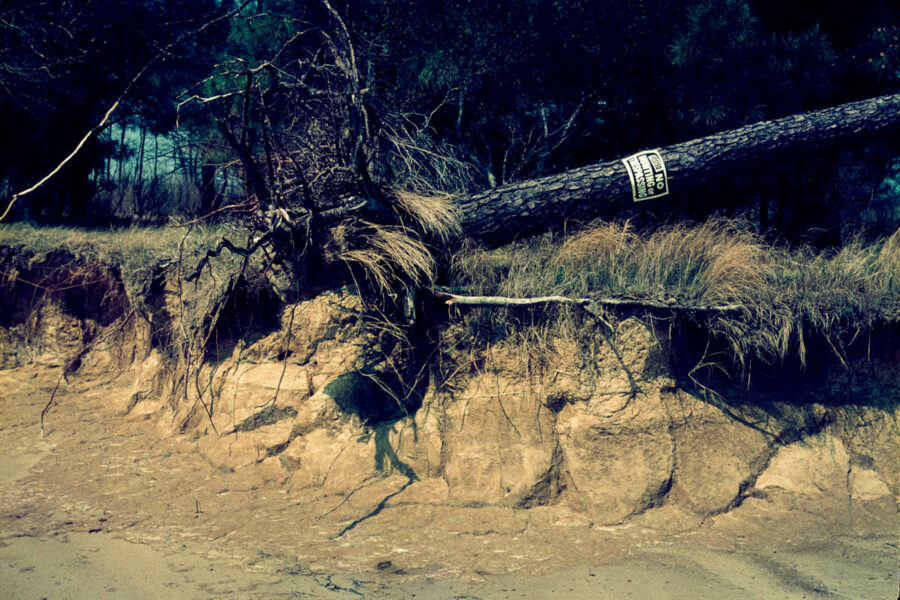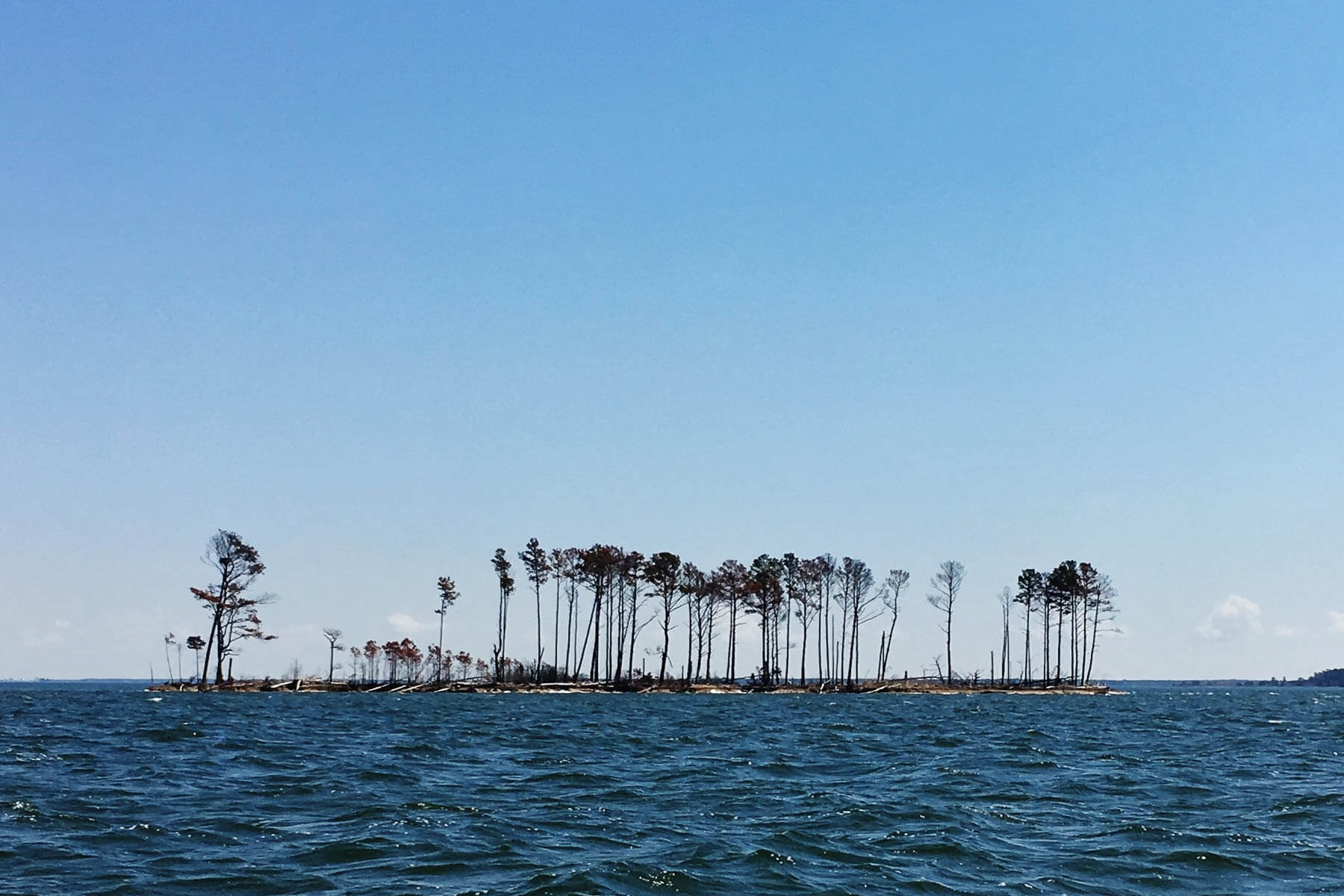A scientist’s decades-long portrait of a vanishing Chesapeake island

For centuries, the islands of the Chesapeake Bay have been shrinking, the result of land subsidence and erosion, compounded by rising seas. Hundreds of smaller islands have vanished completely. Islands that once supported entire communities—with names like Poplar, Holland, Sharps, James and Barren—have fallen silent. On Fox Island, the Chesapeake Bay Foundation recently closed its long-lived education center.
Today, some Chesapeake islands persist, but face both environmental and economic challenges. Communities of several hundred people live on Smith Island in Maryland and Tangier Island in Virginia, but are shrinking along with eroding shorelines and vanishing economic opportunities. On Deal Island, an aging population of watermen is facing the same pressures.
After withering away, Poplar and Hart-Miller islands served as the first two sites for restoration using sediment dredged from shipping channels.
Those massive projects support wildlife, offer recreation opportunities and protect nearby communities from wave action. Soon, an island near the mouth of Maryland’s Little Choptank River, James Island, will be similarly restored.

Getting to know James Island
Kent Mountford, who retired as a senior scientist at the Chesapeake Bay Program in 2000, knows these islands well. He and his wife Nancy moved to Maryland in 1971. Since then, the couple has sailed all over the Chesapeake, logging thousands of miles and hundreds of nights aboard their vessels. Mountford brought a camera loaded with 35mm film and took detailed notes to document their journeys with a scientific eye.
“It was like stepping back to John’s Smith’s time at one point,” Mountford said. “You could collect artifacts from the original settlements on James Island that dated back to the 1600s.”
Mountford’ visual record of James Island shows an island eroding away over nearly five decades. The photos show how erosion eventually fragmented the island into three separate parts—South, Middle and North James Island.
“We didn’t really perceive it as an immediate problem because the island was a mile long,” Mountford said.
For some years, a sandbar connected the fragments.
“It was really cool,” Mountford said. “You could walk along [the sandbar] and you could do it at high tide when the water was rushing over it, slowly sweeping the sand away. And all the while the perimeter of the island was eroding and trees were falling into the water.”
With a new project on the horizon, James Island’s disappearing act will soon come to an end. The U.S. Army Corps of Engineers and the Maryland Port Administration created a plan to restore the shrinking island as well as nearby Barren Island.
Construction will begin on Barren Island and James Island in 2022 and 2024, respectively, using sediment dredged by the Port of Baltimore.
Once spanning over 1,300 acres when it was settled in the early 1660s, James Island will be restored to nearly 2,100 acres.
Learn more about the restoration work planned for James and Barren islands.

Comments
The Maryland Port Authority and the U.S. Army Corps of Engineers analyze the chemical and physical characteristics of sediment removed from Baltimore harbor prior to dredging, placement and/or use. More information on the testing that occurs: https://mpa.maryland.gov/greenport/Documents/FINAL2PGR.Fact.Sheet.Sediment_Quality.august2016.pdf
Information on monitoring from the Maryland Port Authority: https://mpa.maryland.gov/greenport/Documents/MonitoringOctober2018.pdf
The Maryland Department of the Environment is responsible for managing dredging and dredged material. In their most recent guidance, published in December 2019, they note that:
“For the dredging and dredged material placement of federally-maintained channels within Baltimore Harbor by USACE, MDE regulates these activities through a Clean Water Act, Section 401 WQC and a State Discharge Permit for discharges from the Cox Creek DMCF and Masonville DMCF. The WQC, required by the Corps in accordance the CWA, defers to the State Discharge Permit for compliance with the State's water quality standards. The dredging of federally-maintained channels outside of Baltimore Harbor in the tidal areas of the Chesapeake and Atlantic coastal bays is regulated through the Section 401 WQC.
Additionally, it notes that dredged material from Baltimore Harbor must be placed either in contained areas, inside or outside of the harbor only, or for beneficial use projects. Only two active dredged material containment facilities are currently approved for this purpose – Cox Creek and Masonville.
“Dredged material from inside the legally defined Baltimore Harbor will generally require more rigorous sediment characterization, both physical and chemical, and associated monitoring in order to approve beneficial use. Furthermore, Baltimore Harbor dredged material from outside of the regularly maintained navigation channels may require other special characterization and monitoring requirements as a result of proximity to legacy industrial activities. The Department will also consider whether estuarine dredged material will be beneficially used in an environment where it is likely to acidify and produce leachate.”
More information can be found at: https://mde.maryland.gov/programs/Marylander/Pages/dredging.aspx
While older, I also will point you to a Maryland Sea Grant report that studied the sediment in Baltimore harbor: https://www.mdsg.umd.edu/sites/default/files/files/_Dredge_Report_and_Appendices_Web.pdf
How safe is the dredge material out of the Baltimore Harbor ? The Corp has spread this material all over the Bay, because nobody wants it. Will all the dredge material will check daily for comtaminants that could harm the Little Choptank ecosystem ? I have heard from people who worked on the Poplar Island project that 100,000 birds died and hauled away annual from that project. You thoughts Please ?
Thank you!
Your comment has been received. Before it can be published, the comment will be reviewed by our team to ensure it adheres with our rules of engagement.
Back to recent stories